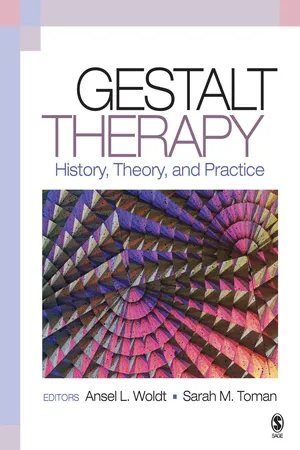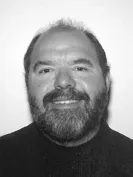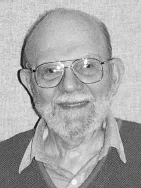
This is a test
- 424 pages
- English
- ePUB (mobile friendly)
- Available on iOS & Android
eBook - ePub
Book details
Book preview
Table of contents
Citations
About This Book
Gestalt Therapy: History, Theory, and Practice is an introductory text, written by major Gestalt theorists, that will engage those new to Gestalt therapy. Editors Ansel Woldt and Sarah M. Toman introduce the historical underpinnings and fundamental concepts of Gestalt therapy and illustrate applications of those concepts to therapeutic practice. The book is unique in that it is the first Gestalt text specifically designed for the academic and training institute settings. Gestalt Therapy takes both a conceptual and a practical approach to examining classic and cutting-edge constructs.
Frequently asked questions
At the moment all of our mobile-responsive ePub books are available to download via the app. Most of our PDFs are also available to download and we're working on making the final remaining ones downloadable now. Learn more here.
Both plans give you full access to the library and all of Perlego’s features. The only differences are the price and subscription period: With the annual plan you’ll save around 30% compared to 12 months on the monthly plan.
We are an online textbook subscription service, where you can get access to an entire online library for less than the price of a single book per month. With over 1 million books across 1000+ topics, we’ve got you covered! Learn more here.
Look out for the read-aloud symbol on your next book to see if you can listen to it. The read-aloud tool reads text aloud for you, highlighting the text as it is being read. You can pause it, speed it up and slow it down. Learn more here.
Yes, you can access Gestalt Therapy by Ansel L. Woldt, Sarah M. Toman in PDF and/or ePUB format, as well as other popular books in Psychology & History & Theory in Psychology. We have over one million books available in our catalogue for you to explore.
Information
Part I
FOUNDATIONS OF GESTALT THERAPY
CHAPTER 1
The History and Development of Gestalt Therapy
CHARLES E. BOWMAN
DIALOGUE RESPONDENT: EDWIN C. NEVIS

Charles E. Bowman is founder, co-president, and senior faculty of the Indianapolis Gestalt Institute in Indiana. A superb teacher and workshop facilitator, he has presented his “Interactive History of Gestalt Therapy” at Gestalt conferences on three continents. He is the author of several articles on Gestalt therapy and serves on the editorial board of Gestalt Review and Electronic Gestalt Journal. An organizational specialist and dynamic leader, he is Director of WorkLife Strategies at Verizon Communications and is former president of the Association for the Advancement of Gestalt Therapy.

Edwin C. Nevis is one of the original pioneers of Gestalt therapy. He is president of the Gestalt International Study Center. He was a founder of the Gestalt Institute of Cleveland, where he was president for 13 years and where he co-founded the International Gestalt Organization and System Development Program, which trains practitioners from over 20 countries. He was founding editor of Gestalt Press and (together with Joe Melnick) conceived the Gestalt Review. He is the author of several articles and books, including Organizational Consulting: A Gestalt Approach (1987), the editor of Gestalt Therapy: Perspectives and Applications (1992), and the coauthor of Intentional Revolutions: A Seven-Point Strategy for Transforming Organizations (1996) and How Organizations Learn: An Integrated Strategy for Building Learning Capability (1998). His career also includes 17 years on the faculty of the Massachusetts Institute of Technology Sloan School of Management.
It is highly instructive to learn something of the intensively tilled soil from which our virtues proudly emerge.
Paul Goodman, “The Father of the
Psychoanalytic Movement”
Psychoanalytic Movement”
The inevitability of identifying Gestalt therapy from one’s own perspective has resulted in multiple definitions of Gestalt therapy and widely differing historical accounts. The typical narrative of Gestalt therapy history can be summarized in Carlyle’s (Strouse & Strouse, 1993) famous maxim that all history is the biography of great men. The “great man” approach to history recounts the legend of a heroic figure (typically male) who individually changes the course of modern history, founds a school of thought, or introduces a new paradigm. In the history of Gestalt therapy, this approach details the contributions of Frederick Perls. Perls’s name has been virtually synonymous with Gestalt therapy, along with his famous “empty chair” technique.
EDWIN:My first response to your chapter, Charlie, was to remember what it was like for me personally to fall into the world of psychology as a student in 1944. I was 18 years old and waiting to be drafted into the military service. My professors in the Psychology Department of the City College of New York introduced us to Wundt, Brentano, Lewin, Koffka, Köhler, Wertheimer, etc. Then, as a teaching assistant, I designed experiments to test Lewinian hypotheses (e.g., the Zeigarnik effect) and had the opportunity to meet Wolfgang Köhler, Kurt Goldstein, and others. I only realized years later how fortunate I was to have been in the presence of these pioneers and to have been exposed to them and their ideas. Imagine my delight about 7 years later to be introduced to Fritz Perls, Laura Perls, Isadore From, and Paul Goodman, and to be among the first to study with them as part of the founding group at the Cleveland Institute. You cannot imagine the excitement we experienced as part of a revolutionary, somewhat underground movement that was to revise and perhaps replace psychoanalysis as a therapy of choice.
CHARLIE:Another area that I would be interested in hearing about, Edwin, is what relationship, if any, existed between Gestalt psychology—Lewin, Köhler, and the gang—and Buber’s approach (or reproach) towards psychotherapy. I am thinking, for instance, about any early connections between I-Thou and figure-ground.
EDWIN:I don’t have any particular knowledge about the relationship between figure-ground and I-Thou in the thinking of the early folks. Buber was more focused on the interpersonal level than the intrapsychic one. I think of figure-ground as awareness phenomena and, as such, belonging to the early stages of contact.
With regard to the movement from Gestalt psychology to Gestalt therapy, I think this reflects the developing split between the practitioners and the scientists in the psychological world. In addition to Lewin’s movement toward social action issues, key books on personality theory from a Gestalt perspective were written by Andra Angyal and Fritz Heider.
On a personal level, when my cohorts and I were exposed to Gestalt and field theory we were also encouraged to become practitioners who would change the world through our interventions. Only a handful of my age-group became Gestalt-oriented scientists (e.g., Leo Postman, Irvin Rock, and Mary Henle).
CHARLIE:Gestalt psychology was primarily relegated to Europe, while Gestalt therapy was germinated and flourished in the United States. I believe this was in part a result of the medical/psychiatric system established in the United States. A Veterans Administration position was a good-paying job for a psychologist or psychotherapist, as was an academic appointment. Gestalt therapy and theory made significant contributions in each realm. In an academic setting one would certainly have found Goodman. Likewise, in a clinical setting one would certainly have heard of the efficiency and success of this new form of therapy and, of course, of Dr. Perls. I am curious, Edwin, how this academic-clinical cleavage appeared to you as you moved from college to career.
EDWIN:The cleavage between academic and practitioner roles was just beginning, and effort developed to keep it from spreading. The concept of the “scientist/practitioner” was developed and continues to be advocated today. However, the cleavage continued. It became a source of great conflict within the American Psychological Association. But it led to clinicians being elected as president of the APA and the growth of independent schools of professional psychology that grant a Doctor of Psychology degree, as opposed to the PhD, which remains a research/academic degree.
Numerous problems plague these traditional historical accounts. Discoveries are glamorized and multiple contributors are ignored. Embarrassing moments are omitted and disciplines are protected at the expense of truth. These “Fritz Perls” accounts are ethnocentric, sexist, shallow, and historically ignorant. They have left Gestalt therapy cemented in the zeitgeist of 1960s popular psychology. Unfortunately, most historical accounts ignore the richness of Gestalt therapy theory as the confluence of many contributions, from physics to feminism, Hasidism to Taoism, and radical individualism to relational psychology, to name just a few. Therefore, this chapter will present the history of Gestalt therapy from a field-theoretical perspective, identifying contributions to Gestalt therapy from an array of cultural, scientific, historical, and aesthetic components of human experience.
The broadest overview of Gestalt therapy identifies a changing weltanschauung as responsible for Gestalt therapy’s development. Weltanschauung connotes more than the dictionary definition, “a shared worldview.” It is how we apprehend the world—how we are involved in it, perceive it, and bring our personal history to bear on it. This collective perspective creates momentum and becomes an engine for change. In Gestalt therapy, the result has been movement (a) from deconstructive views of the world toward holistic models of existence; (b) from linear causality toward field theoretical paradigms; and (c) from an individualistic psychology toward a dialogical or relational perspective.
The following definition of Gestalt therapy reflects the influences of a field perspective on methodology:
Gestalt therapy is a process psychotherapy with the goal of improving one’s contact in community and with the environment in general. This goal is accomplished through aware, spontaneous and authentic dialogue between client and therapist. Awareness of differences and similarities [is] encouraged while interruptions to contact are explored in the present therapeutic relationship. (Bowman, 1998, p. 106)
This definition clearly outlines what a Gestalt therapist does in practice. Viewing the history of Gestalt therapy from a field theoretical perspective makes it possible to see how the various components in this definition have evolved. Understanding the changing weltanschauung adds texture and contour to an already colorful historical account of Gestalt therapy.
Gestalt therapy is celebrating over 50 years of existence, marking the publication of its first comprehensive text, Gestalt Therapy: Excitement and Growth in the Human Personality (Perls, Hefferline, & Goodman, 1951, 1994, hereafter referred to as Gestalt Therapy), and the birth of the first professional training group, the New York Institute for Gestalt Therapy. Though Frederick Perls looms large as the father of Gestalt therapy in the “great man” perspective, he invented neither the theory nor the subject matter, as he acknowledged (Perls, 1969b). The seeds of Gestalt therapy were planted well in advance of Frederick Perls and have fully germinated into a comprehensive theory of psychotherapy and a philosophical foundation for living.
An acquaintance with some of the early contributors in psychoanalysis, psychology, and philosophy only partially illuminates the theory labeled “Gestalt” in 1951. Victorian Europe, the dramatic impact of fascism and world war, the denouement of 1960s liberalism, and the subsequent conservative shift have all interacted to shape the landscape of Gestalt therapy.
THE DESCENT OF GESTALT THERAPY IN PSYCHOANALYSIS
That Freud was a product of Victorian Europe and of nineteenth-century science needs no exegesis. Psychoanalytic theory was a revolutionary method for treating the ailments of a repressed and conservative society. Although Freud clearly identified society as responsible for these ills, his was not a social psychology; his enterprise was clearly medical. William Harvey’s On the Motion of the Heart and Blood in Animals (1628/1993) had set the standard for medical research some 200 years earlier: Organismic functioning could be ascertained through dissection. Freud’s advice to aspiring psychoanalysts illustrates his reliance on this model:
I cannot advise my colleagues too urgently to model themselves during psychoanalytic treatment on the surgeon, who puts aside all his feelings, even his human sympathy, and concentrates his mental forces on the single aim of performing the operation as skillfully as possible. (quoted in Stepansky, 1999, p. 1)
Psychoanalytic dissection allowed classification of psychological functioning—for example, id, ego, and superego. Freud’s careful observations and high degree of skepticism lent scientific credence to his “discoveries,” which astonished Victorian Europe and the safe culture that had developed in Vienna. The world was forever changed.
Psychoanalysis was the starting point for Frederick and Laura Perls. Although their first treatise, Ego, Hunger and Aggression (Perls, 1947/1969a), originally carried the subtitle A Revision of Freud’s Theory and Method, terms such as mental metabolism, figure formation, gestalt/gestalten, organismic balance, zero point, holism, field theory, concentration therapy, face-to-face therapy, present-centered therapy, attending to the actual, undoing retroflections, body concentration, experience, and experiment clearly indicated their departure. The 1969 Random House edition replaced the work’s original subtitle with The Beginning of Gestalt Therapy and added, following Frederick Perls’s name, the dubious credential “Associate Psychiatrist of the Esalen Institute.”
Laura Perls authored two of the chapters in Ego, Hunger and Aggression (Rosenfeld, 1978a). This fact is seldom mentioned. Her interest in oral resistances and Fritz Perls’s theory of dental aggression grew from her experiences of feeding and weaning her children (her phenomenological field). The book emerged from collaborative discussions between Frederick and Laura Perls. Although she was never cited as a coauthor, Frederick nominally acknowledged her contributions in the first edition of the book. This acknowledgment was deleted in the 1969 Random House edition.
The Perlses’ departure from psychoanalysis began when Frederick Perls presented a paper at the 1936 Czechoslovakia Psychoanalytic Congress in Marienbad, disputing the “anal stage” of development as the origin of all resistance. The Perlses’ theory of dental aggression was viewed as heresy and was summarily dismissed. This led the Perlses to reconsider their contributions as revisionist and ultimately to organize the new school of Gestalt therapy.
The “great man” account of the debacle of the 1936 Congress pitted Frederick Perls against Sigmund Freud and the orthodox psychoanalysts. Actually, Marie Bonaparte was the most outspoken critic of Perls’s presentation of oral resistances. Later, as the figure of a new psychotherapy began to emerge, Frederick Perls (1947/1969a) said,
I had studied with a number of psycho-analysts for years. With one exception—K. Laundauer—all those from whom I have derived any benefit have departed from the orthodox lines. . . . This proves, on the one hand, the tremendous stimulation which emanated from Freud but, on the other, it proved the incompleteness or insufficiency of his system. . . . While I was living entirely in the psycho-analytic atmosphere, I could not appreciate that the great opposition to Freud’s theories might have some justification. (p. 81)
Frederick and Laura Perls studied psychoanalysis formally with first-generation analysts. The impact of these analysts is evident in the development of Gestalt therapy. Although Freud would marginalize many of his students for their challenge to the orthodoxy of classical analysis, the stage was set for alternatives to flourish. Rank was exploring the role of the “here and now” in the psychoanalytic setting, while Adler was exploring the role of paradox in therapy. Federn was developing preliminary concepts around ego boundaries, and Ferenzi was championing the active involvement of the analyst and emphasizing the subjective nature of interpretation. The renegade analyst who most directly contributed to Gestalt therapy was assuredly Wilhelm Reich.
Frederick Perls was in analysis with Reich and was attracted to a concept that would later develop into a central tenet of Gestalt therapy: organismic self-regulat...
Table of contents
- Cover Page
- Title Page
- Copyright Page
- Contents
- Acknowledgments
- Prologue–Foreword
- Pre-Text: Gestalt Pedagogy: Creating the Field for Teaching and Learning
- PART I: FOUNDATIONS OF GESTALT THERAPY
- PART II: GESTALT APPLICATIONS WITH SPECIFIC POPULATIONS
- Epilogue
- Comprehensive Reference and Gestalt Book List
- Appendix A: Digital Gestalt: Online Resources for the Discipline of Gestalt Therapy, A Comprehensive International Listing, by Ansel L. Woldt, EdD, and Philip Brownell, PsyD
- Appendix B: Gestalt Experience and Observation Guide for Children: Human Growth and Development From a Gestalt/Wholistic Perspective, by Ansel L. Woldt, EdD
- Author Index
- Subject Index